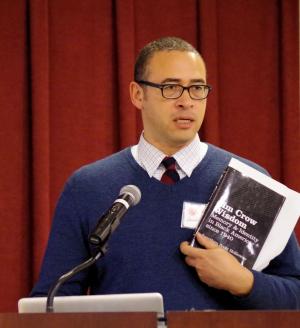Connecticut Academy of Arts and Sciences
Minutes of the CAAS 1441st Meeting
February 10, 2015
Whitney Center, Hamden, CT
Lecture by Jonathan Holloway, Dean of Yale College, Professor of History and American Studies, Professor of African American Studies, Yale University, “Jim Crow Wisdom: Memory and Identity in Black America since 1940”
 The 1441st meeting of the Connecticut Academy of Arts and Sciences was held on Tuesday, February 10, 2015, at the Whitney Center in Hamden, CT.
The 1441st meeting of the Connecticut Academy of Arts and Sciences was held on Tuesday, February 10, 2015, at the Whitney Center in Hamden, CT. The President of CAAS began the meeting by introducing two new members: John Anderson, former director the Connecticut Agricultural Experiment Station in New Haven; and Monica Aspianto who volunteered to be recording secretary for CAAS.
The President then introduced Jonathan Holloway, Dean of Yale College.
Professor Holloway focused much of his talk on his new book “Jim Crow Wisdom, Memory & Identity in Black America since 1940.”
He began his talk by recalling the story of Richard Wright around 1915. His focus was on Stories of Great Thinkers, now on memory. He spoke of family revelations and his own dilemma as a historian as to how to keep family out of his book.
He admitted to being influenced by Thomas Early’s story in Harper’s Magazine that suggested a pathway to creative non-fiction including things that you don’t tell your children. Thus, Holloway began to think on the things that you don’t tell your children. This raised the question of what is real versus what archives tell you. It is a question of the “Oral Tradition.” What do you tell and what don’t you tell to your children?
As an example, he told the story of his Aunt Maggie, his own great aunt, a family historian. It’s his brother’s story of how his Aunt Maggie refused to tell him her history. It was a clear example of “art-full forgetting.”
Holloway’s next focus was on Heritage Museums and the conflict between wanting for forget and the desire to tell a story and then to make money. This conflict raised the problem of trauma versus economy.
 His epilogue was a trip to Ghana where the history of slavery aroused personal reflections. Viewing slave castles was hard to forget especially because he knew he was walking of his ancestors DNA. He struggled to reconcile his London experiences with the Ghanaian experience as a professional historian.
His epilogue was a trip to Ghana where the history of slavery aroused personal reflections. Viewing slave castles was hard to forget especially because he knew he was walking of his ancestors DNA. He struggled to reconcile his London experiences with the Ghanaian experience as a professional historian.
He reported on the impact that the Door of No Return had on him. Finally, he confessed that was he was more at home in the museum that he was in the open space of the adjoining village.
Professor Holloway showed personal photos of Elmina Castle in Ghana where slaves were held 30 feet from the doors of a chapel.
Photographs by Robert Green, CAAS photographer
Minutes submitted by Monica Aspianto, Recording Secretary